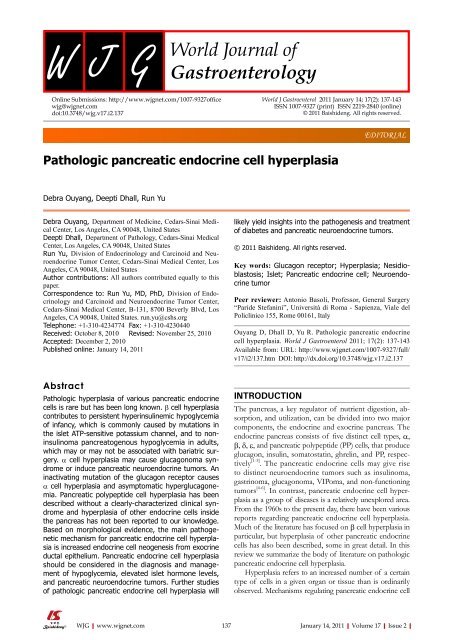Connective tissue growth factor reacts as an IL - World Journal of ...
Connective tissue growth factor reacts as an IL - World Journal of ...
Connective tissue growth factor reacts as an IL - World Journal of ...
Create successful ePaper yourself
Turn your PDF publications into a flip-book with our unique Google optimized e-Paper software.
Online Submissions: http://www.wjgnet.com/1007-9327<strong>of</strong>fice<br />
wjg@wjgnet.com<br />
doi:10.3748/wjg.v17.i2.137<br />
Pathologic p<strong>an</strong>creatic endocrine cell hyperpl<strong>as</strong>ia<br />
Debra Ouy<strong>an</strong>g, Deepti Dhall, Run Yu<br />
Debra Ouy<strong>an</strong>g, Department <strong>of</strong> Medicine, Cedars-Sinai Medical<br />
Center, Los Angeles, CA 90048, United States<br />
Deepti Dhall, Department <strong>of</strong> Pathology, Cedars-Sinai Medical<br />
Center, Los Angeles, CA 90048, United States<br />
Run Yu, Division <strong>of</strong> Endocrinology <strong>an</strong>d Carcinoid <strong>an</strong>d Neuroendocrine<br />
Tumor Center, Cedars-Sinai Medical Center, Los<br />
Angeles, CA 90048, United States<br />
Author contributions: All authors contributed equally to this<br />
paper.<br />
Correspondence to: Run Yu, MD, PhD, Division <strong>of</strong> Endocrinology<br />
<strong>an</strong>d Carcinoid <strong>an</strong>d Neuroendocrine Tumor Center,<br />
Cedars-Sinai Medical Center, B-131, 8700 Beverly Blvd, Los<br />
Angeles, CA 90048, United States. run.yu@cshs.org<br />
Telephone: +1-310-4234774 Fax: +1-310-4230440<br />
Received: October 8, 2010 Revised: November 25, 2010<br />
Accepted: December 2, 2010<br />
Published online: J<strong>an</strong>uary 14, 2011<br />
Abstract<br />
Pathologic hyperpl<strong>as</strong>ia <strong>of</strong> various p<strong>an</strong>creatic endocrine<br />
cells is rare but h<strong>as</strong> been long known. β cell hyperpl<strong>as</strong>ia<br />
contributes to persistent hyperinsulinemic hypoglycemia<br />
<strong>of</strong> inf<strong>an</strong>cy, which is commonly caused by mutations in<br />
the islet ATP-sensitive pot<strong>as</strong>sium ch<strong>an</strong>nel, <strong>an</strong>d to noninsulinoma<br />
p<strong>an</strong>creatogenous hypoglycemia in adults,<br />
which may or may not be <strong>as</strong>sociated with bariatric surgery.<br />
α cell hyperpl<strong>as</strong>ia may cause glucagonoma syndrome<br />
or induce p<strong>an</strong>creatic neuroendocrine tumors. An<br />
inactivating mutation <strong>of</strong> the glucagon receptor causes<br />
α cell hyperpl<strong>as</strong>ia <strong>an</strong>d <strong>as</strong>ymptomatic hyperglucagonemia.<br />
P<strong>an</strong>creatic polypeptide cell hyperpl<strong>as</strong>ia h<strong>as</strong> been<br />
described without a clearly-characterized clinical syndrome<br />
<strong>an</strong>d hyperpl<strong>as</strong>ia <strong>of</strong> other endocrine cells inside<br />
the p<strong>an</strong>cre<strong>as</strong> h<strong>as</strong> not been reported to our knowledge.<br />
B<strong>as</strong>ed on morphological evidence, the main pathogenetic<br />
mech<strong>an</strong>ism for p<strong>an</strong>creatic endocrine cell hyperpl<strong>as</strong>ia<br />
is incre<strong>as</strong>ed endocrine cell neogenesis from exocrine<br />
ductal epithelium. P<strong>an</strong>creatic endocrine cell hyperpl<strong>as</strong>ia<br />
should be considered in the diagnosis <strong>an</strong>d m<strong>an</strong>agement<br />
<strong>of</strong> hypoglycemia, elevated islet hormone levels,<br />
<strong>an</strong>d p<strong>an</strong>creatic neuroendocrine tumors. Further studies<br />
<strong>of</strong> pathologic p<strong>an</strong>creatic endocrine cell hyperpl<strong>as</strong>ia will<br />
WJG|www.wjgnet.com<br />
<strong>World</strong> J G<strong>as</strong>troenterol 2011 J<strong>an</strong>uary 14; 17(2): 137-143<br />
ISSN 1007-9327 (print) ISSN 2219-2840 (online)<br />
© 2011 Baishideng. All rights reserved.<br />
likely yield insights into the pathogenesis <strong>an</strong>d treatment<br />
<strong>of</strong> diabetes <strong>an</strong>d p<strong>an</strong>creatic neuroendocrine tumors.<br />
© 2011 Baishideng. All rights reserved.<br />
Key words: Glucagon receptor; Hyperpl<strong>as</strong>ia; Nesidiobl<strong>as</strong>tosis;<br />
Islet; P<strong>an</strong>creatic endocrine cell; Neuroendocrine<br />
tumor<br />
Peer reviewer: Antonio B<strong>as</strong>oli, Pr<strong>of</strong>essor, General Surgery<br />
“Paride Stef<strong>an</strong>ini”, Università di Roma - Sapienza, Viale del<br />
Policlinico 155, Rome 00161, Italy<br />
Ouy<strong>an</strong>g D, Dhall D, Yu R. Pathologic p<strong>an</strong>creatic endocrine<br />
cell hyperpl<strong>as</strong>ia. <strong>World</strong> J G<strong>as</strong>troenterol 2011; 17(2): 137-143<br />
Available from: URL: http://www.wjgnet.com/1007-9327/full/<br />
v17/i2/137.htm DOI: http://dx.doi.org/10.3748/wjg.v17.i2.137<br />
INTRODUCTION<br />
EDITORIAL<br />
The p<strong>an</strong>cre<strong>as</strong>, a key regulator <strong>of</strong> nutrient digestion, absorption,<br />
<strong>an</strong>d utilization, c<strong>an</strong> be divided into two major<br />
components, the endocrine <strong>an</strong>d exocrine p<strong>an</strong>cre<strong>as</strong>. The<br />
endocrine p<strong>an</strong>cre<strong>as</strong> consists <strong>of</strong> five distinct cell types, α,<br />
β, δ, ε, <strong>an</strong>d p<strong>an</strong>creatic polypeptide (PP) cells, that produce<br />
glucagon, insulin, somatostatin, ghrelin, <strong>an</strong>d PP, respectively<br />
[1-3] . The p<strong>an</strong>creatic endocrine cells may give rise<br />
to distinct neuroendocrine tumors such <strong>as</strong> insulinoma,<br />
g<strong>as</strong>trinoma, glucagonoma, VIPoma, <strong>an</strong>d non-functioning<br />
tumors [4-6] . In contr<strong>as</strong>t, p<strong>an</strong>creatic endocrine cell hyperpl<strong>as</strong>ia<br />
<strong>as</strong> a group <strong>of</strong> dise<strong>as</strong>es is a relatively unexplored area.<br />
From the 1960s to the present day, there have been various<br />
reports regarding p<strong>an</strong>creatic endocrine cell hyperpl<strong>as</strong>ia.<br />
Much <strong>of</strong> the literature h<strong>as</strong> focused on β cell hyperpl<strong>as</strong>ia in<br />
particular, but hyperpl<strong>as</strong>ia <strong>of</strong> other p<strong>an</strong>creatic endocrine<br />
cells h<strong>as</strong> also been described, some in great detail. In this<br />
review we summarize the body <strong>of</strong> literature on pathologic<br />
p<strong>an</strong>creatic endocrine cell hyperpl<strong>as</strong>ia.<br />
Hyperpl<strong>as</strong>ia refers to <strong>an</strong> incre<strong>as</strong>ed number <strong>of</strong> a certain<br />
type <strong>of</strong> cells in a given org<strong>an</strong> or <strong>tissue</strong> th<strong>an</strong> is ordinarily<br />
observed. Mech<strong>an</strong>isms regulating p<strong>an</strong>creatic endocrine cell<br />
137 J<strong>an</strong>uary 14, 2011|Volume 17|Issue 2|

















